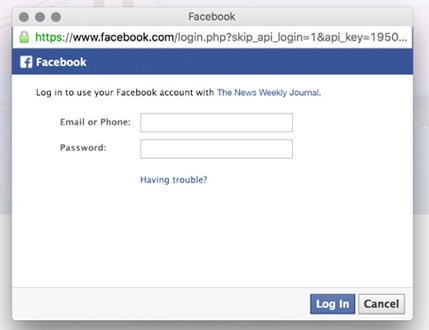New type of phishing attack you may fall prey to easily!
By MYBRANDBOOK

Well when you are visiting a blog or e-commerce site are you sure the Site is a Legal?
If a website is asking for your credentials to get some discounts or confirming for certain service, do you know whether it is fake or real to log in?
By checking if the URL is correct?
By checking if the website is address and not a homograph?
By checking if the site is using HTTPS?
Or using software or browser extensions that detect phishing domains?
Like most Internet users, without relying on the above basic security practices to spot if that "Facebook.com" or "Google.com" you have been served with is fake or not, you may fall victim to a newly discovered creative phishing attack and end up in giving away your passwords to hackers.
Antoine Vincent Jebara, co-founder and CEO of password managing software, Myki currently reported on a news channel that his team recently spotted a new phishing attack campaign "that even the most vigilant users could fall for."
Vincent found that cybercriminals are distributing links to blogs and services that prompt visitors to first "login using Facebook account" to read an exclusive article or purchase a discounted product.
That’s fine. Login with Facebook or any other social media service is a safe method and is being used by a large number of websites to make it easier for visitors to sign up for a third-party service quickly.
Generally, when you click "log in with Facebook" button available on any website, you either get redirected to facebook.com or are served with facebook.com in a new pop-up browser window, asking you to enter your Facebook credentials to authenticate using OAuth and permitting the service to access your profile’s necessary information.
However, Vincent discovered that the malicious blogs and online services are serving users with a very realistic-looking fake Facebook login prompt after they click the login button which has been designed to capture users’ entered credentials, just like any phishing site.

The fake pop-up login prompt, actually created with HTML and JavaScript, are perfectly reproduced to look and feel exactly like a legitimate browser window - a status bar, navigation bar, shadows and URL to the Facebook website with green lock pad indicating a valid HTTPS.
Moreover, users can also interact with the fake browser window, drag it here-and-there or exit it in the same way any legitimate window acts.
The only way to protect yourself from this type of phishing attack, according to Vincent, "is to actually try to drag the prompt away from the window it is currently displayed in. If dragging it out fails (part of the popup disappears beyond the edge of the window), it's a definite sign that the popup is fake."
Besides this, it is always recommended to enable two-factor authentication with every possible service, preventing hackers from accessing your online accounts if they somehow manage to get your credentials.
Phishing schemes are still one of the most severe threats to users as well as companies, and hackers continue to try new and creative ways to trick you into providing them with your sensitive and financial details that they could later use to steal your money or hack into your online accounts.


Nazara and ONDC set to transform in-game monetization with ‘
Nazara Technologies has teamed up with the Open Network for Digital Comme...

Jio Platforms and NICSI to offer cloud services to government
In a collaborative initiative, the National Informatics Centre Services In...

BSNL awards ₹5,000 Cr Project to RVNL-Led Consortium
A syndicate led by Rail Vikas Nigam Limited (abbreviated as RVNL), along wi...

Pinterest tracks users without consent, alleges complaint
A recent complaint alleges that Pinterest, the popular image-sharing platf...


Icons Of India : MUKESH D. AMBANI
Mukesh Dhirubhai Ambani is an Indian businessman and the chairman and ...

ICONS OF INDIA : SANTHOSH VISWANATHAN
Santhosh Viswanathan is the the Vice President and Managing Director f...

Icons Of India : ASHISH KUMAR CHAUHAN
Ashish kumar Chauhan, an Indian business executive and administrator, ...


PFC - Power Finance Corporation Ltd
PFC is a leading financial institution in India specializing in power ...

IREDA - Indian Renewable Energy Development Agency Limited
IREDA is a specialized financial institution in India that facilitates...

NPCI - National Payments Corporation of India
NPCI is an umbrella organization for operating retail payments and set...


Indian Tech Talent Excelling The Tech World - JAYASHREE ULLAL, President and CEO - Arista Network
Jayshree V. Ullal is a British-American billionaire businesswoman, ser...

Indian Tech Talent Excelling The Tech World - NIKESH ARORA, Chairman CEO - Palo Alto Networks
Nikesh Arora, the Chairman and CEO of Palo Alto Networks, is steering ...

Indian Tech Talent Excelling The Tech World - JAY CHAUDHRY, CEO – Zscaler
Jay Chaudhry, an Indian-American technology entrepreneur, is the CEO a...